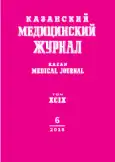Легочная гипертензия и показатели функции внешнего дыхания при органосберегающей хирургии рака легкого
- Авторы: Киршин А.А.1,2, Напольских В.М.2
-
Учреждения:
- Республиканский клинический онкологический диспансер им. С.Г. Примушко
- Ижевская государственная медицинская академия
- Выпуск: Том 99, № 6 (2018)
- Страницы: 876-879
- Тип: Теоретическая и клиническая медицина
- URL: https://ogarev-online.ru/kazanmedj/article/view/10499
- DOI: https://doi.org/10.17816/KMJ2018-876
- ID: 10499
Цитировать
Полный текст
Аннотация
Цель. Оценить влияние легочной гипертензии на показатели функции внешнего дыхания в хирургии рака легкого.
Материал и методы. В объеме различных вариантов ангиопластической лобэктомии (АПЛ) оперированы 92 пациента с диагнозом «немелкоклеточный рак легкого», из них 69 мужчин (75 %) и 23 женщины (25 %), средний возраст составил 57,8 ± 6,7 лет. В объеме пульмонэктомии (ПЭ) оперирован 91 пациент, из них 87 мужчин (95,6 %) и 4 женщины (4,4 %), средний возраст составил 59 ± 8,8 лет.
Результаты. Через год после ангиопластической лобэктомии ОФВ1 (объем форсированного выдоха за секунду) снизился на 0,69 л (27 %), ЖЕЛ (жизненная емкость легких) уменьшилась на 1,17 л (32,9 %), ФЖЕЛ (разница между объемами воздуха в легких в точках начала и конца маневра форсированного выдоха) редуцировалась на 0,64 л (20,5 %). После удаления легкого динамика убыли аналогичных показателей составила 1,02 л (42 %); 1,53 л (43,8 %); 1,24 л (40,3 %) соответственно. Выявлено наличие отрицательной связи между показателями РА/А (легочная артерия / аорта) и ОФВ1. Так, в группе ангиопластической лобэктомии без исходной легочной гипертензии (РА/А - менее 1) установлено, что r = -0,42 (p < 0,01), при наличии легочной гипертензии (РА/А - 1 и более) r = -0,4 (p < 0,01). В группе пульмонэктомии без исходной легочной гипертензии показатель корреляции составил -0,38 (p < 0,01), при наличии исходной легочной гипертензии r = -0,33 (p < 0,01).
Выводы. При анализе функциональных показателей легочной системы после операций выявлено статистически достоверное преимущество органосберегающего лечения, а также отрицательная корреляционная связь между легочной гипертензией и показателями функции внешнего дыхания.
Ключевые слова
Полный текст
Открыть статью на сайте журналаОб авторах
Александр Александрович Киршин
Республиканский клинический онкологический диспансер им. С.Г. Примушко; Ижевская государственная медицинская академия
Автор, ответственный за переписку.
Email: kirshinalex80@mail.ru
г. Ижевск, Россия
Владимир Михайлович Напольских
Ижевская государственная медицинская академия
Email: kirshinalex80@mail.ru
г. Ижевск, Россия
Список литературы
- Brunelli A., Berrisford R.G., Rocco G., Varela G. European Society of Thoracic Surgeons Database Committee. The European Thoracic Database project: composite performance score to measure quality of care after major lung resection. Eur. J. Cardiothorac. Surg. 2009; 35: 769-774.doi: 10.1016/j.ejcts.2009.01.037.
- Brunelli A., Refai M., Salati M., Pompili C., Sabbatini A. Standardized combined outcome index as an instrument for monitoring performance after pulmonary resection. Ann. Thorac. Surg. 2011; 92: 272-277. doi: 10.1016/j.athoracsur.2011.03.038.
- Merkow R.P., Bilimoria K.Y., McCarter M.D., Cohen M.E., Barnett C.C., Raval M.V., et al. Post-discharge venous thromboembolism after cancer surgery: extending the case for extended prophylaxis. Ann. Surg. 2011; 254: 131-137. doi: 10.1097/SLA.0b013e31821b98da.
- Phillips J.D., Merkow R.P., Sherman K.L., DeCamp M.M., Bentrem D.J., Bilimoria K.Y. Factors affecting selection of operative approach and subsequent short-term outcomes after anatomic resection for lung cancer. J. Am. Coll. Surg. 2012; 215: 206-215. DOI: 10.1016/ j.jamcollsurg.2012.04.016.
- Ferguson M.K., Parma C.M., Celauro A.D., Vigneswaran W.T. Quality of life and mood in older patients after major lung resection. Ann. Thorac. Surg. 2009; 87: 1007-1013. doi: 10.1016/j.athoracsur.2008.12.084.
- Pompili C., Brunelli A., Xiumé F., Refai M., Salati M., Sabbatini A. Predictors of postoperative decline in quality of life after major lung resections. Eur. J. Cardiothorac. Surg. 2011; 39: 732-737. doi: 10.1016/j.ejcts.2010.08.046.
- Yang P., Cheville A.L., Wampfler J.A., Garces Y.I., Jatoi A., Clark M.M., et al. Quality of life and symptom burden among long-term lung cancer survivors. J. Thorac. Oncol. 2012; 7: 64-70. doi: 10.1097/JTO.0b013e3182397b3e.
- Wei B., D’Amico T., Samad Z., Hasan R., Berry M.F. The impact of pulmonary hypertension on morbidity and mortality following major lung resection. Europ. J. Cardio-Thorac. Surg. 2014; 45: 1028-1033. doi: 10.1093/ejcts/ezt495.
- Rudski L.G., Lai W.W., Afilalo J., Hua L., Handschumacher M.D., Chandrasekaran K., Solomon S.D., Louie E.K., Schiller N.B. Guidelines for the echocardiographic assessment of the right heart in adults: a report from the American Society of Echocardiography endorsed by the European Association of Echocardiography, a registered branch of the European Society of Cardiology, and the Canadian Society of Echocardiography. J. Am. Soc. Echocardiogr. 2010; 23 (7): 685-713. doi: 10.1016/j.echo.2010.05.010.
- Asakura K., Mitsuboshi S., Tsuji M., Sakamaki H., Otake S., Matsuda S., Kaseda K., Watanabe K. Pulmonary arterial enlargement predicts cardiopulmonary complications after pulmonary resection for lung cancer: a retrospective cohort study. Europ. J. Cardio-Thorac. Surg. 2015; 10: 113. doi: 10.1186/s13019-015-0315-9.
Дополнительные файлы






